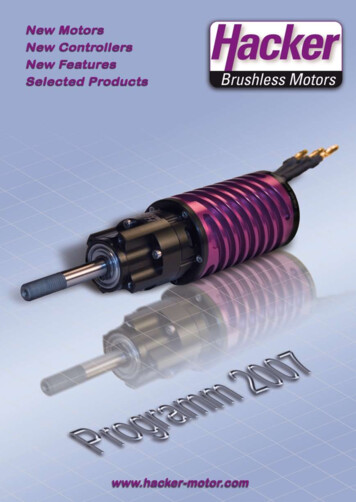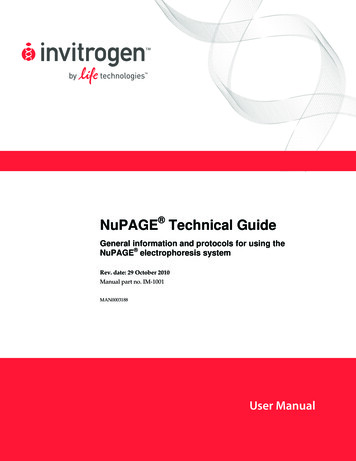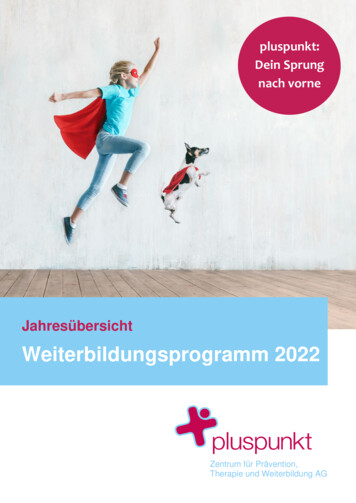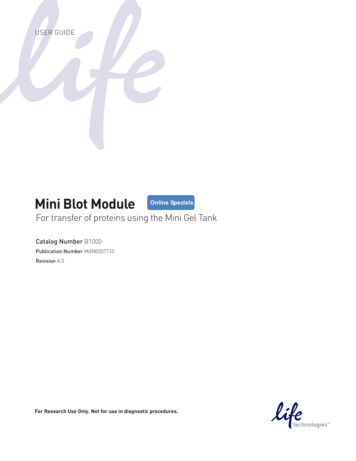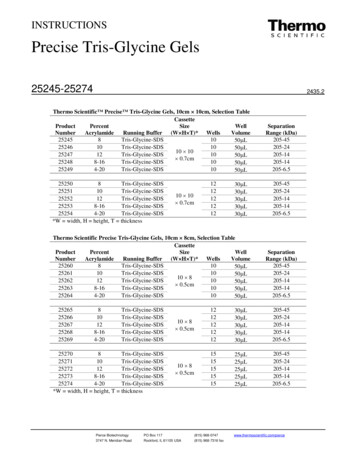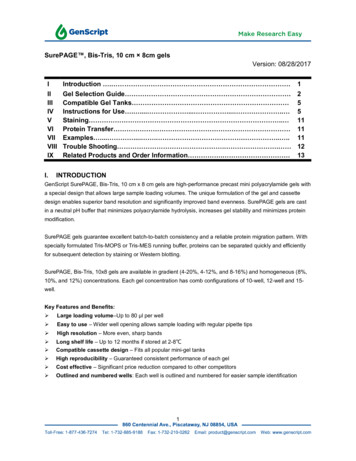
Transcription
SurePAGE , Bis-Tris, 10 cm 8cm gelsVersion: 08/28/2017IIntroductionIIIIIIVVVIVIIVIIIIXGel Selection GuideCompatible Gel TanksInstructions for Use . .StainingProtein TransferExamples .Trouble ShootingRelated Products and Order InformationI.1.2551111111213. .INTRODUCTIONGenScript SurePAGE, Bis-Tris, 10 cm x 8 cm gels are high-performance precast mini polyacrylamide gels witha special design that allows large sample loading volumes. The unique formulation of the gel and cassettedesign enables superior band resolution and significantly improved band evenness. SurePAGE gels are castin a neutral pH buffer that minimizes polyacrylamide hydrolysis, increases gel stability and minimizes proteinmodification.SurePAGE gels guarantee excellent batch-to-batch consistency and a reliable protein migration pattern. Withspecially formulated Tris-MOPS or Tris-MES running buffer, proteins can be separated quickly and efficientlyfor subsequent detection by staining or Western blotting.SurePAGE, Bis-Tris, 10x8 gels are available in gradient (4-20%, 4-12%, and 8-16%) and homogeneous (8%,10%, and 12%) concentrations. Each gel concentration has comb configurations of 10-well, 12-well and 15well.Key Features and Benefits:Large loading volume–Up to 80 µl per wellEasy to use – Wider well opening allows sample loading with regular pipette tipsHigh resolution – More even, sharp bandsLong shelf life – Up to 12 months if stored at 2-8 Compatible cassette design – Fits all popular mini-gel tanksHigh reproducibility – Guaranteed consistent performance of each gelCost effective – Significant price reduction compared to other competitorsOutlined and numbered wells: Each well is outlined and numbered for easier sample identification1
II. GEL SELECTION GUIDETable 1. Gel Selection GuideMax.Well 653No. icineTris-BicineTris-BicineTris-BicineTris-Bicine
The protein migration table below can help you to choose the appropriate gel for your protein electrophoresis.For best results select a gel that allows the best separation for your sample’s molecular weight range. For awide range of molecular weights you may want to select a gradient gel.Table 2. Protein Migration Table with MOPS running buffer3
Table 3: Protein Migration Table with MES running buffer (M00677). Use MES buffer for separation of smallerproteins ( 50kD).4
III. COMPATIBLE GEL TANKSSurePAGE, Bis-Tris, 10x8 are compatible with the following Gel Tanks:Bio-Rad Mini-PROTEAN II & 3*Bio-Rad Mini-PROTEAN Tetra System*Invitrogen Novex XCell I, II, & Surelock (Use with GenScript Gel Tank Adapter Plates)LONZA PAGEr Minigel ChamberHoefer Mighty Small (SE 260/SE 250)Hoefer Tall Mighty Small (SE 280)*please reverse the gasket, see instructions belowIV. Instructions for using SurePAGE, Bis-Tris, 10x8 gelsA. Prepare the Gel Buffer and Gel Tank1. Dissolve one pack of Tris-MOPS-SDS Running Buffer Powder (Cat. No. M00138) in 1 L deionizedwater to make 1 L 1x MOPS running buffer.If you’re using MES buffer, dissolve one pack of MES SDS Running Buffer Powder (Cat. No. M00677)in 1 L deionized water to make 1 L 1x MES running buffer.Refer to Section B for recipes of MOPS or MES running buffer.2. Remove SurePAGE, Bis-Tris, 10x8 gel from the package, peel off the sealing tape at the bottom of thegel cassette (see Figure 1).Figure 1. Peel the tape off from the bottom of the cassette5
3. Gently remove the comb from the gel cassette (see Figure 2).Figure 2. Remove the comb from the gel cassette4. Insert the gel into the gel running apparatus.Refer to the apparatus manufacturer’s instructions.Notes for Using Bio-Rad Mini-PROTEAN Tetra System: remove the gasket from the inner electrodeassembly, flip it around so the flat side of the gasket is facing outwards and insert the gasket back into theinner electrode assembly (see Figure 3).Figure 3. Use of SurePAGE, Bis-Tris, 10x8 in Bio-Rad Mini-PROTEAN Tetra System6
Notes for using Invitrogen Novex Mini-Cell tanks: Adapters provided in the package are needed since theSurePAGE, Bis-Tris, 10x8 cassette is thinner than the Invitrogen NuPAGE gel cassette. Each gel needs oneadaptor.See figure 4 for use of SurePAGE, Bis-Tris, 10x8 in the Invitrogen Novex Mini-Cell.Figure 4. Use of SurePAGE, Bis-Tris, 10x8 in Invitrogen Novex Mini-Cell5. Pour sufficient 1x MOPS or MES running buffer into the inner tank of the gel running apparatus untilthe buffer is above the top of the comb. Fill the outer tank with the same running buffer to ensureproper cooling. For best results, the buffer level in the outer tank should be above the top of thesample wells.(NOTE: Do NOT use Tris-glycine running buffer for SurePAGE, Bis-Tris, 10x8.)6. Rinse the sample wells thoroughly with 1x running buffer to remove air bubbles and replace anystorage buffer.7
B.Prepare the sample1. Sample preparationFor best result, we recommend using 4X LDS sample buffer (M00676) as the sampleloading buffer. An alternative SDS sample buffer is 5x sample buffer (MB01015). Please refer to thetable below on buffer and sample preparation.With 4X LDS sample buffer (recommended) (M00676)ReagentSample4X LDS sample buffer1M DTT (10X)Deionized WaterTotal VolumeVolumex2.5µl1µlTo 6.5µl10µlHeat samples at 70 C for 10 minutes before loading.Buffer formulations4X LDS sample buffer:Tris HClTris BaseLithium dodecyl sulfate (LDS)EDTAGlycerolSERVA Blue G250 (1% solution)Phenol Red (1% solution)Deionized water0.666g0.682g0.800g0.006g4g0.75ml0.25mlto 10 mlStore at 4 C. The buffer is stable for 6 months when stored at 4 C.The pH of the 1X solution is 8.5. Do not adjust the pH with acid or base.1 MES running buffer:Tris baseMESSDSEDTADeionized water6.06 g9.76g1.0g0.3gto 1000 ml10x MOPS running buffer:Tris baseMOPSSDSEDTADeionized water60.6 g104.6g10.0g3.0gto 1000 ml8
2. Running the sampleProtein sample loading.Make sure the loading tip is inserted vertically into the loading well for optimal results.Figure 5. Sample loadingNote: Optimal sample volume should be established by trial and error. Protein overloading willcause smearing and band distortion. Overloading with samples containing high content of freecarbohydrates may also lead to band distortion or prevent the protein from entering the gel (SeeTroubleshooting).Place the electrical cover onto the gel running cassette and plug the electrical leads into the powersupply (red to red and black to black). Run the gel at 140 volts for 45-55 minutes until the dye frontreaches the bottom of the gel, depending on the sizes of the proteins of interest (Table 3).Table 3. Electrophoresis conditions for SurePAGE, Bis-Tris, 10x8, one gelVoltageStartFinishRun Time per Gel*140 V (Recommended)75-100 mA30-50 mA45-55 minutes* The run time here is under laboratory temperature of 20 C with Tris-MOPS-SDS buffer. Gel running timevaries under different laboratory temperatures.Important notes: Make sure to use a compatible gel tank. Leaking between the inner and outer tank willcause slow migration rate. (See Troubleshooting)The running time may also vary depending on your power supply and gel concentration.9
3. Removing the gel from the Cassette (see Figure 6)a. Once electrophoresis is finished, remove the gel cassette from the gel tank.b. There are three contact points between the two plates on each side of the gel cassette. Openthe gel cassette by carefully inserting the cassette opener into the gap between the two platesand flanking one of the contact points.c.Gently wiggle the cassette opener up and down to separate the two plates. Repeat theoperation along both sides of the cassette until the two plates are completely separated. Acracking sound may be heard as you open the cassette. It is possible for the gel cassette tocrack while opening it. Please wear goggles for protection.d. Upon opening, carefully remove and discard the plates and place the gel in water. Pleasedispose the used cassettes as non-hazardous medical waste.Figure 6. Open the gel cassette and remove the gel.C.StorageGels are stable for up to 12 months if stored at 2-8oC. See package cover for expiration date.10
V. STAININGAll standard SDS PAGE gel staining procedures can be used with SurePAGE, Bis-Tris, 10x8. When usingcommercially available staining reagents and devices, follow the manufacturer’s instructions.eStain L1 Staining (Cat No. L00657)ExpressPlus and SurePAGE gels can be stained using GenScript’s eStain L1 Protein Staining Systemwhich allows quick staining of gels in 10 minutes. Check the website for more -staining-system.htmlVI. PROTEIN TRANSFERAll standard transferring procedures can be used with SurePAGE, Bis-Tris, 10x8. We recommend Tris Bicinetransfer buffer (Cat. No. M00139)If you are transferring your gel, DO NOT STAIN the gel before the transfer.VII. ExamplesFigure 7. Protein separation using 4-12% SurePAGE, Bis-Tris, 10x8Proteins were separated on a 12-well, 4-12% SurePAGE, Bis-Tris, 10x8 (L) and a 12-well, 4-12%SurePAGE, Bis-Tris, 10x8 (R) and then stained using the eStain L1 Protein Staining System (R250).(L): Lane 1, 3, 5, 7, 9, 11: 4 µl Color Prestained Protein Standard, Broad Range (11-245kDa)(P7712S);Lane 2, 4, 6, 8, 10, 12: 6 µl E.coli cell lysate.(R): Lane 1, 2, 3, 4, 12: 4 µl GenScript PAGE-MASTER Protein Standard (for SDS-PAGE)(M00516);Lane 5, 6, 7, 8: 6 µl E.coli cell lysate;Lane 9, 10, 11: 50 ng/ 25 ng/ 12.5 ng BSA.11
VIII. TROUBLESHOOTINGProblemsDistorted proteinbandsSome part of thetracking dye changedto yellowProbable causeSolutionUse a syringe or a pipette to flush the sampleAir bubbles in the sample wellssample loadingBuffer enters gel because ofGel tank is not compatible or cassette wasbroken cassettedamagedPrepare new running buffer with deionizedpH value decreasedwater. Check pHInsoluble or weakly chargedStreakingparticles (such as carbohydrates)in sampleElectrophoresis timewells thoroughly with running buffer beforeHeat sample in the presence of SDS,centrifuge sample and load the supernatantSeal is not removed from thePeel the seal off from the bottom of cassettebottom of the cassettebefore loadingis too longUse fixed voltage and automated current, e.g.Incorrect running conditions140V throughout the electrophoresisUse the protein migration table to choose theIncorrect gel percentageappropriate gelReduce sample loading amount, especiallySample overloadingwhen the sample contains many kinds ofBands are not wellprotein.separatedInsufficient SDS in loading bufferInsufficient buffer to keep tankcoolSample spreadingacross the gelSample contains too much saltouter tank during runreach the set valuebetween the gel andthe cassetteAdd more buffers to the outer tank until it’s atthe same level or above the top of the sampleReduce salt content by dialysis or ultrafiltrationUse compatible gel tankReduce salt content by dialysis or ultra-Excess salt in the sampleLots of air bubblespreparationwellsLeaking between the inner andThe voltage cannotIncrease SDS content in the sample duringfiltrationRunning buffer is hot afterAdd more running buffer to the outer tankelectrophoresis12
IX. RELATED PRODUCTS AND ORDER INFORMATIONProductCat. No.4x LDS sample bufferM006765x Sample BufferMB01015MES SDS Running Buffer PowderM00677Tris-MOPS-SDS Running Buffer PowderM00138Tank Adaptor (for use with Novex gel tanks)L00671Cassette openerL00674Buffer DamL00699Transfer Buffer PowderM00139eStain L1 Protein Staining DeviceL00657eStain L00659-1L1 Protein staining kitBroad Multi Color Pre-Stained Protein StandardM00624Smart Advanced Broad-Range Protein StandardM00441Smart Dual Color Pre-Stained Protein StandardM00442Smart Multi Color Pre-Stained Protein StandardM00443Protein Marker for Fluorescent Western BlottingM00124PAGE-MASTER Protein Standard (for SDS-PAGE)M00516PAGE-MASTER Protein Standard PlusMM1397-500WB-MASTER Protein StandardM00521GenScript USA Inc.860 Centennial Ave., Piscataway, NJ 08854Tel: 732-885-9188, 732-885-9688Fax: 732-210-0262, 732-885-5878Email: product@genscript.comWeb: http://www.genscript.comFor Research Use Only13
Buffer Transfer Buffer M00652 4-12% 10 80µl MOPS/MES Tris-Bicine M00653 4-12% 12 60µl MOPS/MES Tris-Bicine M00654 4-12% 15 40µl MOPS/MES . 10x8 cassette is thinner than the Invitrogen NuPAGE gel cassette. Each gel needs one adaptor. See figure 4 for use of SurePAGE, Bis-Tris, 10x8 in the Invitrogen Novex Mini-Cell. Figure 4.

